Invasive Species: Dipsacus laciniatus, Cutleaf Teasel
Cutleaf teasel is an invasive perennial plant that grows as a basal rosette until sending up a flowering stalk that can reach 6 to 7 ft. (1.8 to 2.1 m) in height. The small white flowers densely cover oval flower heads and are present from July to September. Spiny bracts are located on the ends of flower stems. Opposite leaves are joined at the base and form cups that surround the prickly stem. Cutleaf teasel grows in open, sunny habitats preferring roadsides and other disturbed areas, although it can sometimes be found in high-quality areas such as prairies, savannas, seeps, and sedge meadows. Cutleaf teasel was introduced from Europe in the 1700s and spreads by producing abundant seeds. It can be found in the northern states from Massachusetts to Colorado.
What are invasive species and why should we be concerned about them?
Taxonomy: Scientific and Common Names for This Species
Dipsacales > Dipsacaceae > Dipsacus laciniatus L.
Synonym(s): cut-leaved teasel
Dipsacus laciniatus – USDA PLANTS Profile
Distribution Maps
Cutleaf teasel – The reported distribution of this invasive species across the United States. (Source: Invasive Plant Atlas of the United States)
Up-to-the-minute distribution maps and why they are important
Reporting This Invasive Species
What is the best way and place to report the occurrence of an invasive species?
How to report an invasive species sighting to EDDMapS – Early Detection & Distribution Mapping System
EDDMapS – Report an Invasive Species to EDDMapS
Cooperative Extension Offices – Find your local Cooperative Extension office on this map provided by USDA
How to Identify
This invasive species can be identified by looking for the characteristics described in the paragraphs that follow.
Plant
Cutleaf teasel is an invasive perennial plant that grows as a basal rosette until sending up a flowering stalk that can reach 6 to 7 ft. (1.8 to 2.1 m) in height.
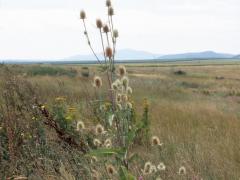 |
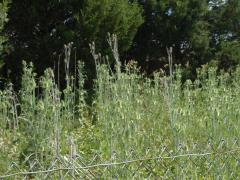 |
| Joy Viola, Northeastern University, bugwood.org | Chris Evans, River to River CWMA, bugwood.org |
Foliage
Opposite leaves are joined at the base and form cups that surround the prickly stem.
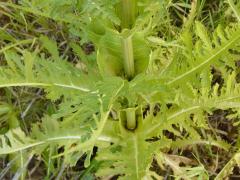 |
 |
| bugwood.org | bugwood.org |
Flower
The small white flowers densely cover oval flower heads and are present from July to September. Spiny bracts are located on the ends of flower stems.
 |
 |
| Chris Evans, River to River CWMA, bugwood.org | Chris Evans, River to River CWMA, bugwood.org |
Fruit
It spreads by producing abundant seeds.
 |
 |
| Bruce Ackley, Ohio State University, bugwood.org | Chris Evans, River to River CWMA, bugwood.org |
Native Species That Resemble Cutleaf Teasel
Eryngium leavenworthii , Leavenworth’s eryngo – Images at invasive.org
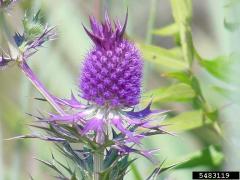 |
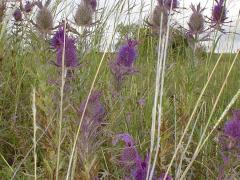 |
| Fort Worth Nature Center and Refuge Archive, City of Fort Worth, bugwood.org | Fort Worth Nature Center and Refuge Archive, City of Fort Worth, bugwood.org |
– Images at invasive.org
| bugwood.org | bugwood.org |
Additional Images for Cutleaf Teasel
Cutleaf teasel – Images at Invasive.org
Learning Resources for Cutleaf Teasel
Additional Information, Biology, Control and Management Resources
Control and management recommendations vary according to individual circumstances. Location, habitat, weather, and a variety of other conditions are factors that help determine the best treatment choice. To find the safest and most effective treatment for your situation, consult your state’s land-grant institution. If you will use chemicals as part of the control process, always refer to the product label.
United States Land-Grant University System – Find your land-grant university’s College of Agriculture, Cooperative Extension Service, or other related partner on this map provided by USDA.
New Invasive Plants of the Midwest Fact Sheet – Midwest Invasive Plant Network
Cutleaf Teaseal – Kansas Wildflowers & Grasses
Dipsacus laciniatus L. – Missouriplants.com
Invasive.org – Center for Invasive Species and Ecosystem Health
Cut-Leaved Teasel – Illinois Wildflowers
